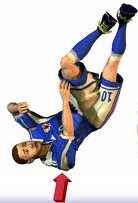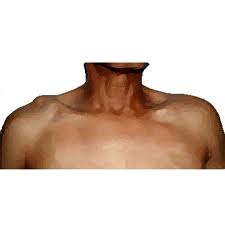Introduction
A separation of the shoulder is one of the most common injuries that can happen to the shoulder in an athlete. It typically happens due to a collision or due to a fall onto the point of the shoulder. Football players often get tackled landing on the point of the shoulder resulting in a separated shoulder. Additionally, bicycle riders will often have a fall, again landing on the point of their shoulder causing injury to the acromioclavicular joint, also known as a separated shoulder.
Anatomy
From an anatomical standpoint, one has to realize that the arm, including the shoulder blade, is attached to the main axial skeleton through the clavicle. The shoulder blade is just attached to the chest wall through a series of muscles called the scapular rotator muscles. The arm is held onto the shoulder blade by the glenohumeral ball and socket joint. This all is attached up to the clavicle through the acromioclavicular joint. The acromion is the part of the scapula at the very point of the shoulder where your shirt sleeve sits. This is what attaches to the clavicle.
There are three main ligaments that support the acromioclavicular joint. One ligament is a thickening of the joint capsule directly between the acromion and the clavicle. There are two coracoclavicular ligaments that hold the scapula and the arm up to the clavicle. It is these ligaments that are disrupted when the shoulder separation occurrs
What Happens
In a acromioclavicular or AC joint separation, an injury happens to one or more of these supportive ligaments. The injury is typically graded I through III depending on the severity of the disruption. A grade III is the worst . The main stabilizing coracoclavicular ligaments are torn and the arm drops down. It is most evident that there is a prominent end of the clavicle at the point of the shoulder. It is not that the clavicle goes up, but rather that the rest of the shoulder girdle goes downward. A grade I injury occurs when the relationship of the bones stay the same when the injury happens. There is pain, but no dislocation of the AC joint. A grade II is somewhere between these two extremes.
grade III is the worst . The main stabilizing coracoclavicular ligaments are torn and the arm drops down. It is most evident that there is a prominent end of the clavicle at the point of the shoulder. It is not that the clavicle goes up, but rather that the rest of the shoulder girdle goes downward. A grade I injury occurs when the relationship of the bones stay the same when the injury happens. There is pain, but no dislocation of the AC joint. A grade II is somewhere between these two extremes.
Symptoms
The symptoms may range from simply tenderness over the joint, to a complete dislocation of the acromioclavicular (AC) joint as seen in the grade 3 separation. There may be a considerable amount of swelling if the separation is grade 2 or 3. A bluish discoloration of the skin due to bruising may occur several days after the injury. In the grade three separation you may feel a popping sensation due to the loose joint shifting. There is usually a noticeable bump on the shoulder if the joint has completely dislocated.
Diagnosis
The diagnosis is typically made by the findings on the history and physical examination. What one is typically looking for in the examination is not just where the tenderness is, but also whether there is truly a separation and whether this separation is unstable.
truly a separation and whether this separation is unstable.
An x-ray is often done as well to compare side-to-side if there has been some difference in the relationship of the clavicle and the acromion from a disruption of these ligaments. No additional imaging studies are typically necessary.
Treatment
The treatment of a separated shoulder is usually conservative management. That is, surgery is not typically indicated for this particular injury. Grade I injuries hurt, but they get better by themselves. One may treat a grade I AC injury with some activity modification, avoiding collision-type activities for a period of time, oral anti-inflammatory medications, and maybe a sling to help take the weight of the arm off the injured joint. Even higher grade injuries such as grade Ii or grade III separations can often be treated conservatively, and will often stabilize themselves. Although, the bones might not be in exactly the right position, but studies show that this typically does not matter. Full function with no pain usually returns.
There is a subset of higher degree acromioclavicular joint injuries that do not stabilize. Sometimes the clavicle will get embedded into the trapezius muscle above and will prevent any stabilization of this joint. In these particular cases, surgery is indicated.
My favorite surgical procedure to address this is to reconstruct these coracoclavicular ligaments with an allograft-type procedure. This secures the joint in a stabilized position and also provides a biological construct for long-term stability and healing. This procedure is call an allograft modified Weaver-Dunn procedure.
There is some debate that in selected patients, especially higher level athletes that require overhead throwing motions, that perhaps early reconstruction surgically might be indicated rather than waiting and seeing if it might become a problem later. This will be discussed directly with you depending on your athletic endeavors and your particular injury.
For those patients treated conservatively, there will also be a subset of these who, because of the disruption of the joint and a disruption in the relationship of the two bones, later on may develop what is called acromioclavicular (AC) joint arthrosis. That is, the two bones, because they do not have the exact normal relationship, will become a source of pain later. This can be easily addressed, if it comes up in the future, by an arthroscopic shoulder procedure to separate the two bones so they do not rub together anymore. Again, this does not happen in all cases, so typically, if this is initially treated conservatively, most of these will never need to have anything else done. All these options should be discussed with your doctor at the time of your presentation.
